Minor Assignment - IT101, Semester 1, University Name: Analysis Report
VerifiedAdded on 2023/06/10
|7
|1372
|388
Homework Assignment
AI Summary
This document presents a comprehensive solution to a minor assignment, addressing key concepts in information technology and logical reasoning. The assignment explores hypothesis testing, its applications in Big Data analysis, and the trial-and-error method, illustrated with examples from IT systems development. It also includes an analysis of arguments using truth tables and addresses the concept of electronic device reliability. The solution provides detailed responses to four questions, including definitions, examples, logical proofs, and analysis of arguments, all supported by cited references. The document is a valuable resource for students seeking to understand and solve similar assignments related to IT and logical reasoning.
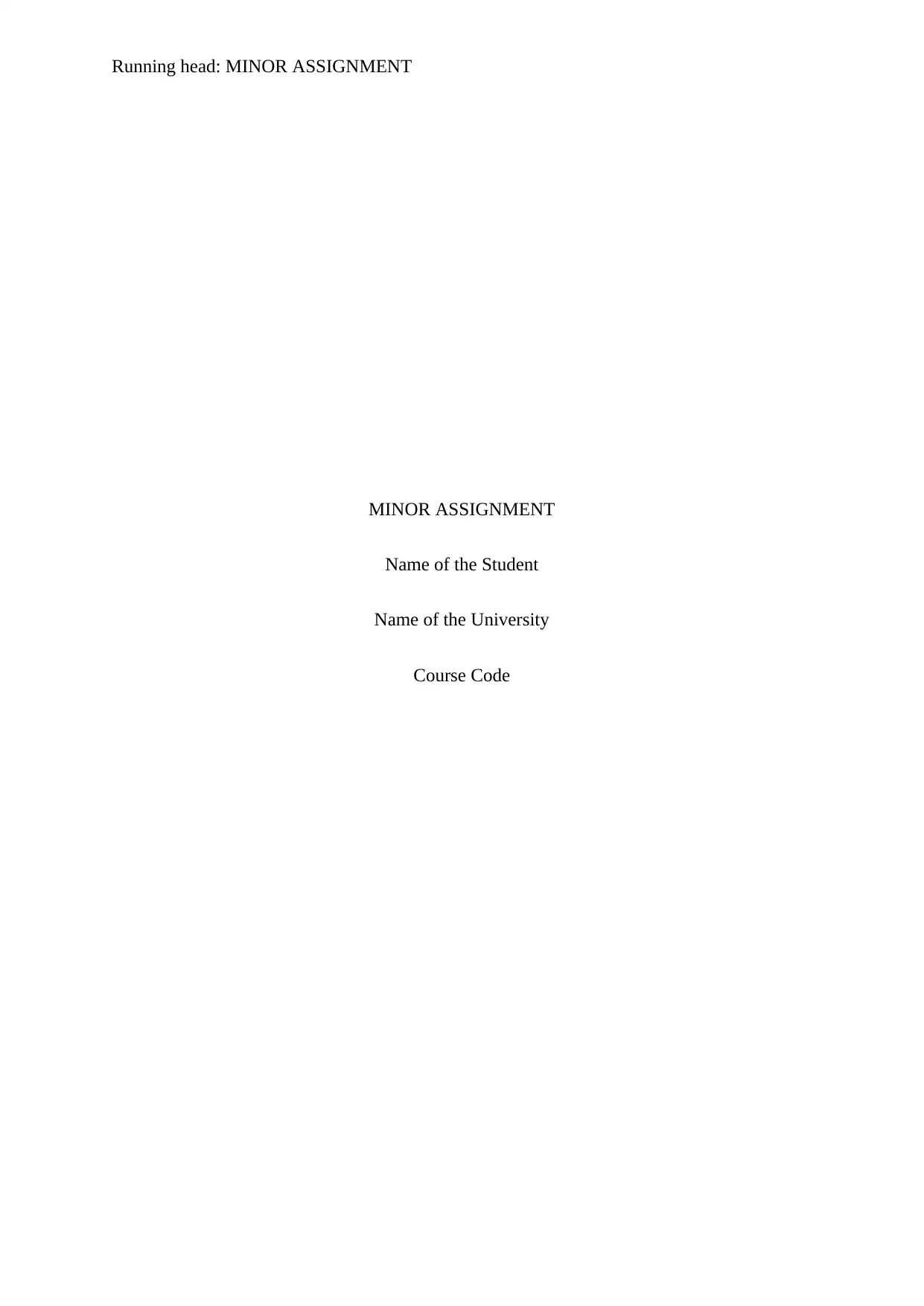
Running head: MINOR ASSIGNMENT
MINOR ASSIGNMENT
Name of the Student
Name of the University
Course Code
MINOR ASSIGNMENT
Name of the Student
Name of the University
Course Code
Paraphrase This Document
Need a fresh take? Get an instant paraphrase of this document with our AI Paraphraser
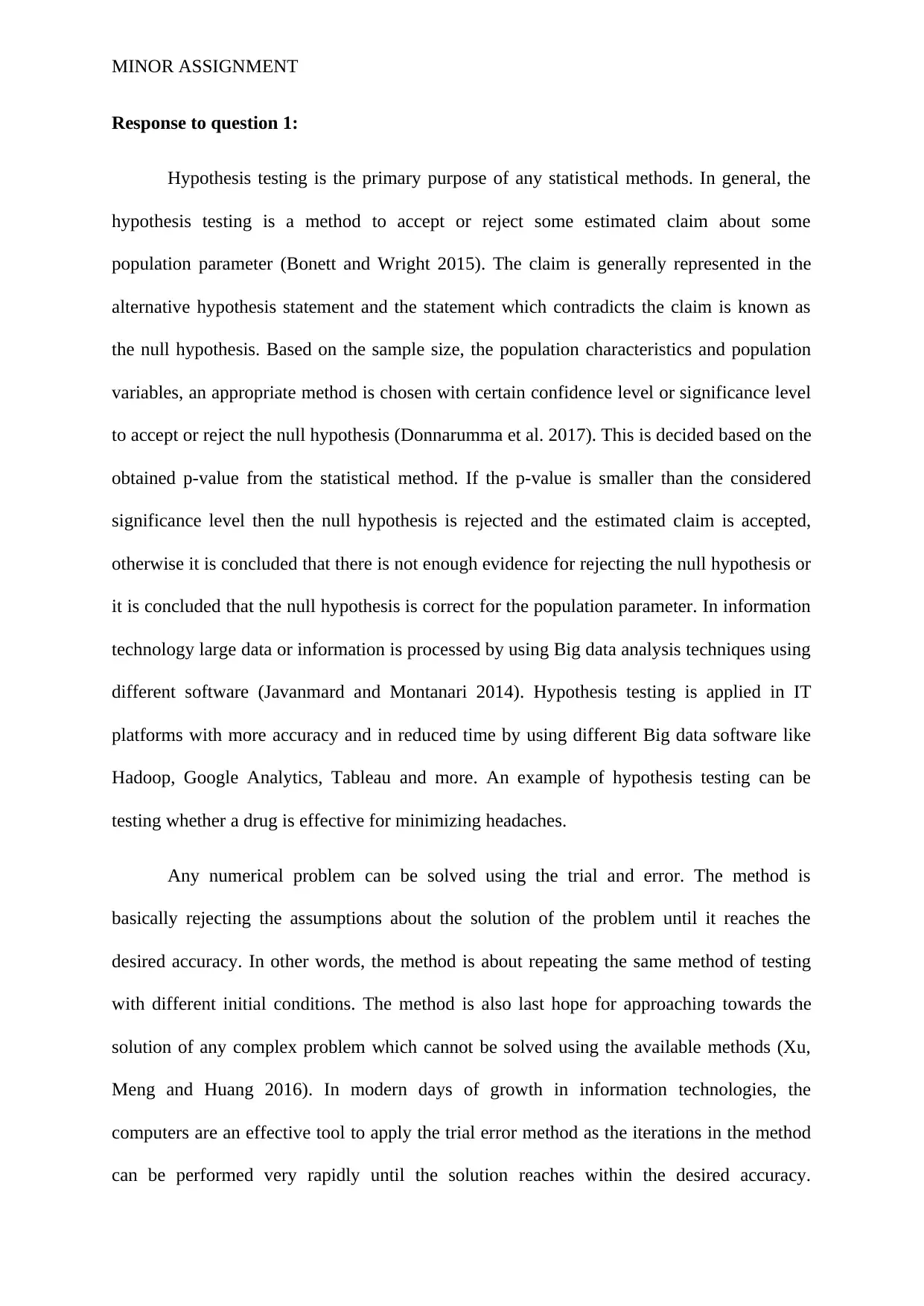
MINOR ASSIGNMENT
Response to question 1:
Hypothesis testing is the primary purpose of any statistical methods. In general, the
hypothesis testing is a method to accept or reject some estimated claim about some
population parameter (Bonett and Wright 2015). The claim is generally represented in the
alternative hypothesis statement and the statement which contradicts the claim is known as
the null hypothesis. Based on the sample size, the population characteristics and population
variables, an appropriate method is chosen with certain confidence level or significance level
to accept or reject the null hypothesis (Donnarumma et al. 2017). This is decided based on the
obtained p-value from the statistical method. If the p-value is smaller than the considered
significance level then the null hypothesis is rejected and the estimated claim is accepted,
otherwise it is concluded that there is not enough evidence for rejecting the null hypothesis or
it is concluded that the null hypothesis is correct for the population parameter. In information
technology large data or information is processed by using Big data analysis techniques using
different software (Javanmard and Montanari 2014). Hypothesis testing is applied in IT
platforms with more accuracy and in reduced time by using different Big data software like
Hadoop, Google Analytics, Tableau and more. An example of hypothesis testing can be
testing whether a drug is effective for minimizing headaches.
Any numerical problem can be solved using the trial and error. The method is
basically rejecting the assumptions about the solution of the problem until it reaches the
desired accuracy. In other words, the method is about repeating the same method of testing
with different initial conditions. The method is also last hope for approaching towards the
solution of any complex problem which cannot be solved using the available methods (Xu,
Meng and Huang 2016). In modern days of growth in information technologies, the
computers are an effective tool to apply the trial error method as the iterations in the method
can be performed very rapidly until the solution reaches within the desired accuracy.
Response to question 1:
Hypothesis testing is the primary purpose of any statistical methods. In general, the
hypothesis testing is a method to accept or reject some estimated claim about some
population parameter (Bonett and Wright 2015). The claim is generally represented in the
alternative hypothesis statement and the statement which contradicts the claim is known as
the null hypothesis. Based on the sample size, the population characteristics and population
variables, an appropriate method is chosen with certain confidence level or significance level
to accept or reject the null hypothesis (Donnarumma et al. 2017). This is decided based on the
obtained p-value from the statistical method. If the p-value is smaller than the considered
significance level then the null hypothesis is rejected and the estimated claim is accepted,
otherwise it is concluded that there is not enough evidence for rejecting the null hypothesis or
it is concluded that the null hypothesis is correct for the population parameter. In information
technology large data or information is processed by using Big data analysis techniques using
different software (Javanmard and Montanari 2014). Hypothesis testing is applied in IT
platforms with more accuracy and in reduced time by using different Big data software like
Hadoop, Google Analytics, Tableau and more. An example of hypothesis testing can be
testing whether a drug is effective for minimizing headaches.
Any numerical problem can be solved using the trial and error. The method is
basically rejecting the assumptions about the solution of the problem until it reaches the
desired accuracy. In other words, the method is about repeating the same method of testing
with different initial conditions. The method is also last hope for approaching towards the
solution of any complex problem which cannot be solved using the available methods (Xu,
Meng and Huang 2016). In modern days of growth in information technologies, the
computers are an effective tool to apply the trial error method as the iterations in the method
can be performed very rapidly until the solution reaches within the desired accuracy.
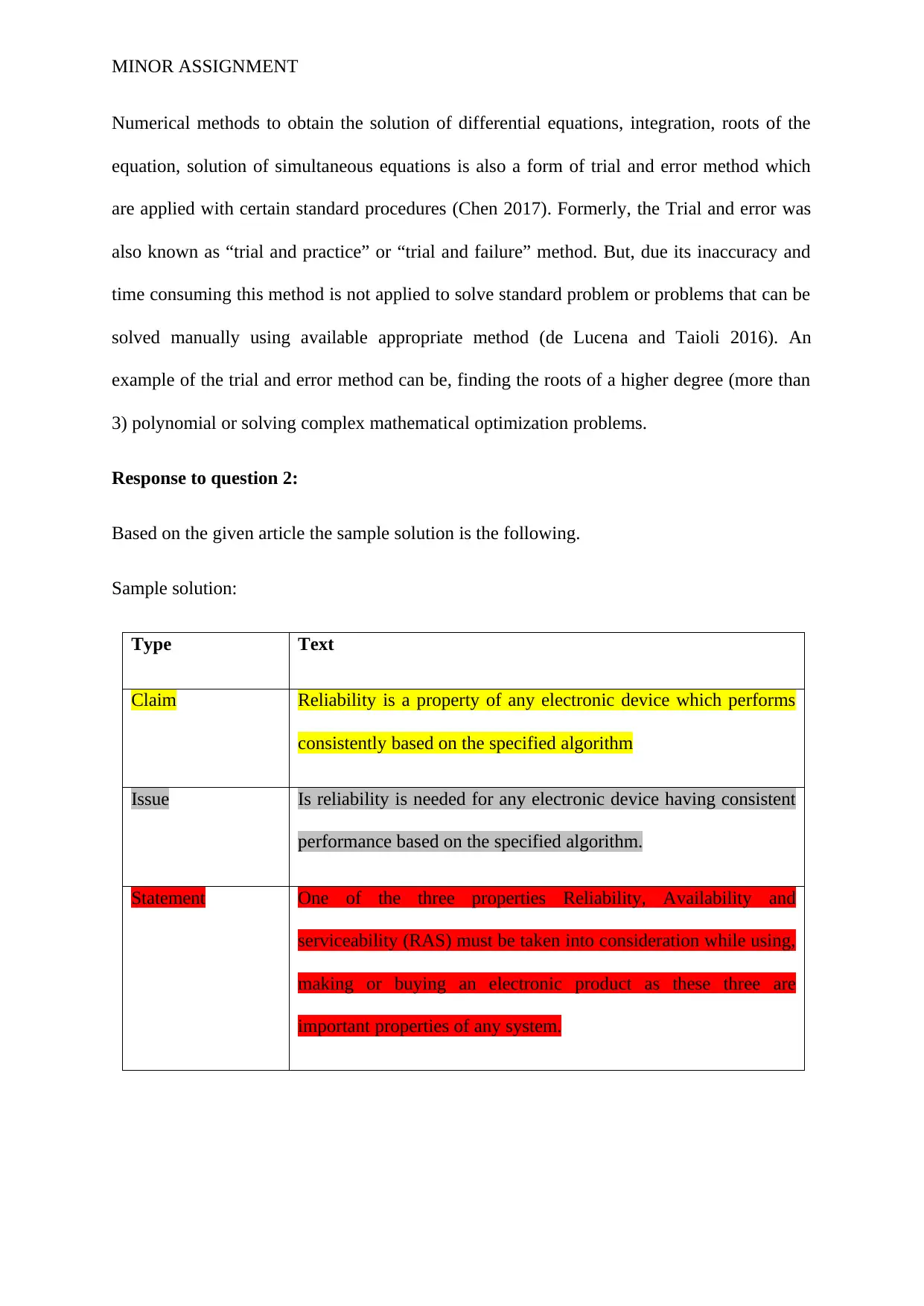
MINOR ASSIGNMENT
Numerical methods to obtain the solution of differential equations, integration, roots of the
equation, solution of simultaneous equations is also a form of trial and error method which
are applied with certain standard procedures (Chen 2017). Formerly, the Trial and error was
also known as “trial and practice” or “trial and failure” method. But, due its inaccuracy and
time consuming this method is not applied to solve standard problem or problems that can be
solved manually using available appropriate method (de Lucena and Taioli 2016). An
example of the trial and error method can be, finding the roots of a higher degree (more than
3) polynomial or solving complex mathematical optimization problems.
Response to question 2:
Based on the given article the sample solution is the following.
Sample solution:
Type Text
Claim Reliability is a property of any electronic device which performs
consistently based on the specified algorithm
Issue Is reliability is needed for any electronic device having consistent
performance based on the specified algorithm.
Statement One of the three properties Reliability, Availability and
serviceability (RAS) must be taken into consideration while using,
making or buying an electronic product as these three are
important properties of any system.
Numerical methods to obtain the solution of differential equations, integration, roots of the
equation, solution of simultaneous equations is also a form of trial and error method which
are applied with certain standard procedures (Chen 2017). Formerly, the Trial and error was
also known as “trial and practice” or “trial and failure” method. But, due its inaccuracy and
time consuming this method is not applied to solve standard problem or problems that can be
solved manually using available appropriate method (de Lucena and Taioli 2016). An
example of the trial and error method can be, finding the roots of a higher degree (more than
3) polynomial or solving complex mathematical optimization problems.
Response to question 2:
Based on the given article the sample solution is the following.
Sample solution:
Type Text
Claim Reliability is a property of any electronic device which performs
consistently based on the specified algorithm
Issue Is reliability is needed for any electronic device having consistent
performance based on the specified algorithm.
Statement One of the three properties Reliability, Availability and
serviceability (RAS) must be taken into consideration while using,
making or buying an electronic product as these three are
important properties of any system.
⊘ This is a preview!⊘
Do you want full access?
Subscribe today to unlock all pages.

Trusted by 1+ million students worldwide
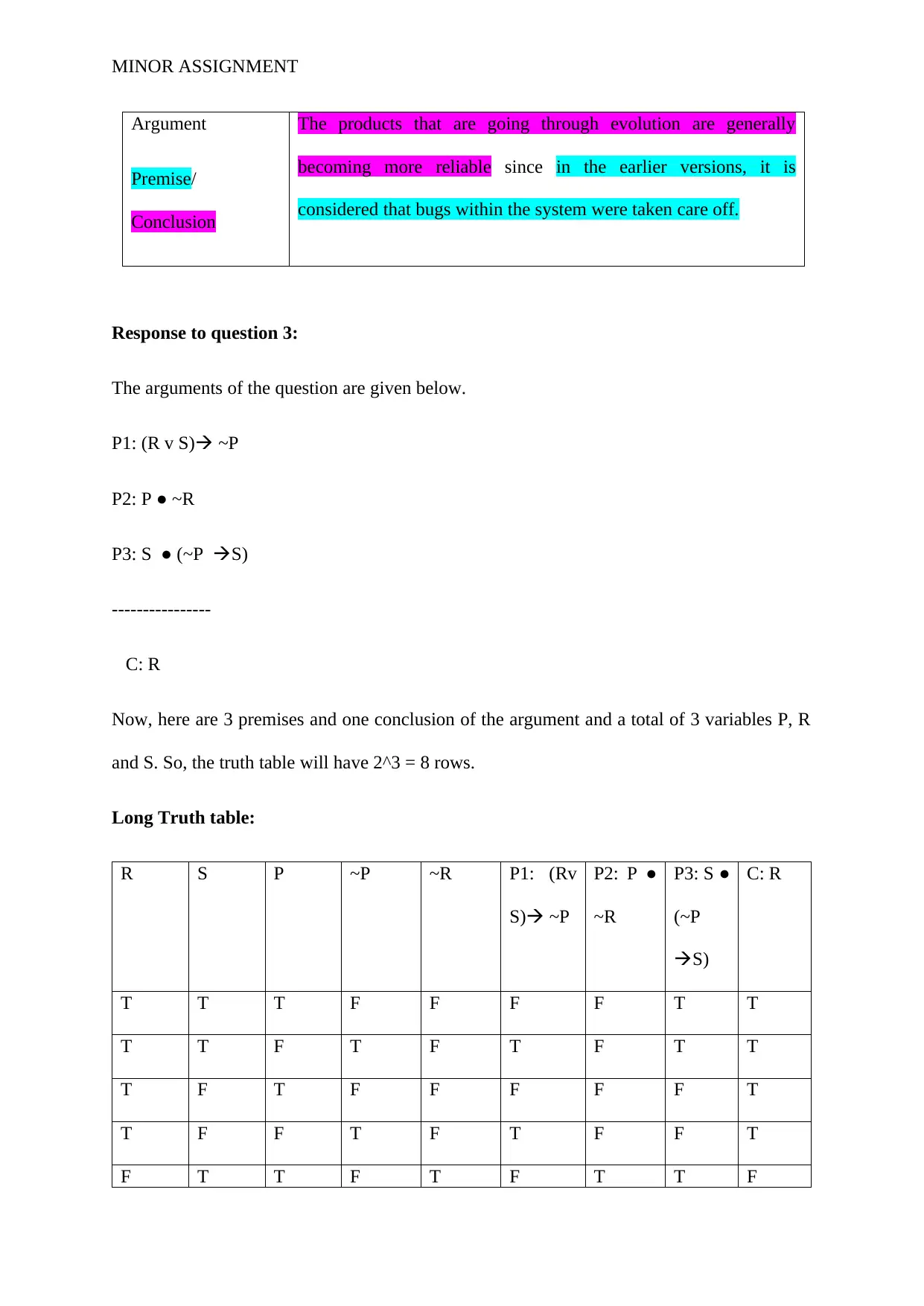
MINOR ASSIGNMENT
Argument
Premise/
Conclusion
The products that are going through evolution are generally
becoming more reliable since in the earlier versions, it is
considered that bugs within the system were taken care off.
Response to question 3:
The arguments of the question are given below.
P1: (R v S) ~P
P2: P ● ~R
P3: S ● (~P S)
----------------
C: R
Now, here are 3 premises and one conclusion of the argument and a total of 3 variables P, R
and S. So, the truth table will have 2^3 = 8 rows.
Long Truth table:
R S P ~P ~R P1: (Rv
S) ~P
P2: P ●
~R
P3: S ●
(~P
S)
C: R
T T T F F F F T T
T T F T F T F T T
T F T F F F F F T
T F F T F T F F T
F T T F T F T T F
Argument
Premise/
Conclusion
The products that are going through evolution are generally
becoming more reliable since in the earlier versions, it is
considered that bugs within the system were taken care off.
Response to question 3:
The arguments of the question are given below.
P1: (R v S) ~P
P2: P ● ~R
P3: S ● (~P S)
----------------
C: R
Now, here are 3 premises and one conclusion of the argument and a total of 3 variables P, R
and S. So, the truth table will have 2^3 = 8 rows.
Long Truth table:
R S P ~P ~R P1: (Rv
S) ~P
P2: P ●
~R
P3: S ●
(~P
S)
C: R
T T T F F F F T T
T T F T F T F T T
T F T F F F F F T
T F F T F T F F T
F T T F T F T T F
Paraphrase This Document
Need a fresh take? Get an instant paraphrase of this document with our AI Paraphraser
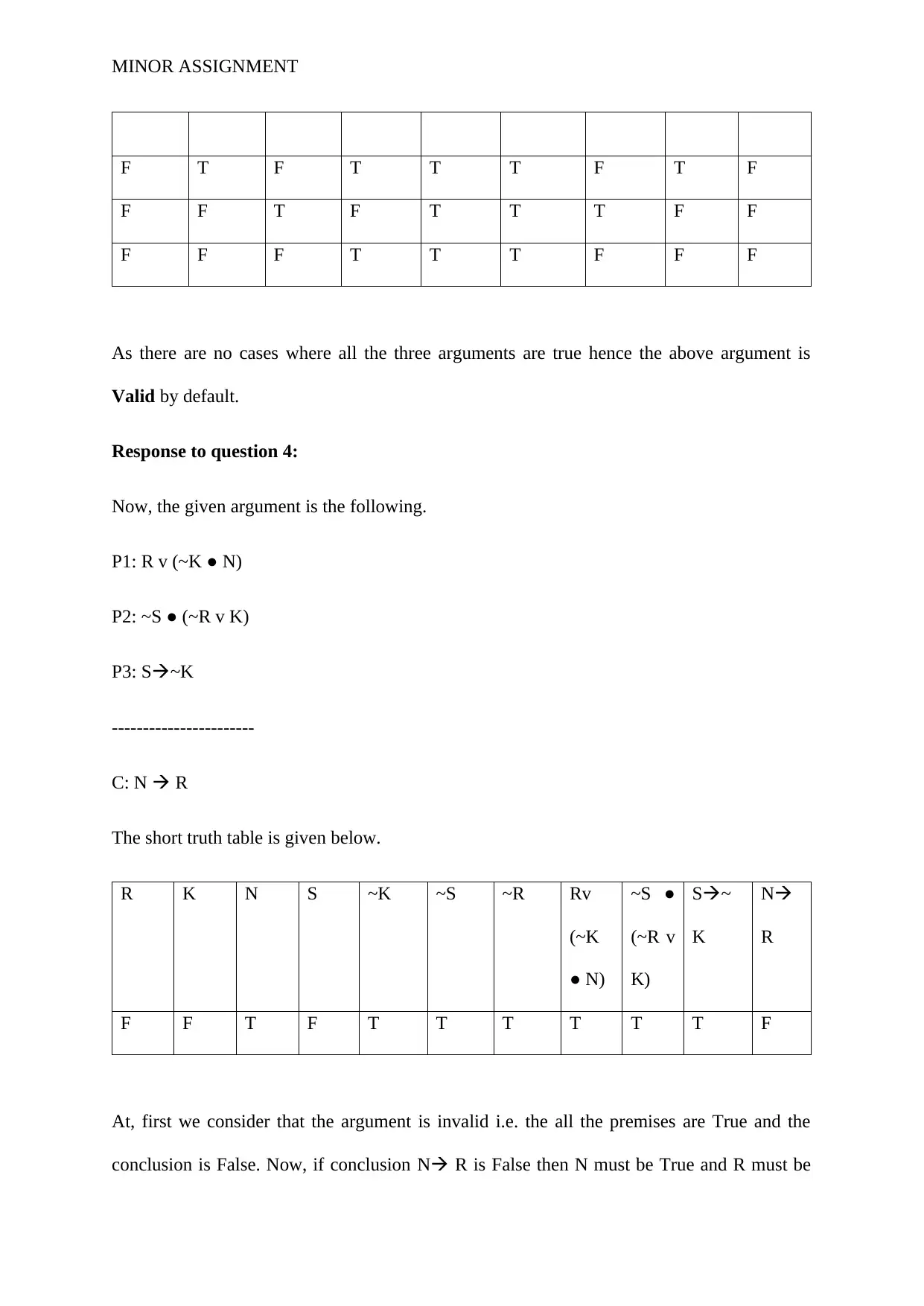
MINOR ASSIGNMENT
F T F T T T F T F
F F T F T T T F F
F F F T T T F F F
As there are no cases where all the three arguments are true hence the above argument is
Valid by default.
Response to question 4:
Now, the given argument is the following.
P1: R v (~K ● N)
P2: ~S ● (~R v K)
P3: S~K
-----------------------
C: N R
The short truth table is given below.
R K N S ~K ~S ~R Rv
(~K
● N)
~S ●
(~R v
K)
S~
K
N
R
F F T F T T T T T T F
At, first we consider that the argument is invalid i.e. the all the premises are True and the
conclusion is False. Now, if conclusion N R is False then N must be True and R must be
F T F T T T F T F
F F T F T T T F F
F F F T T T F F F
As there are no cases where all the three arguments are true hence the above argument is
Valid by default.
Response to question 4:
Now, the given argument is the following.
P1: R v (~K ● N)
P2: ~S ● (~R v K)
P3: S~K
-----------------------
C: N R
The short truth table is given below.
R K N S ~K ~S ~R Rv
(~K
● N)
~S ●
(~R v
K)
S~
K
N
R
F F T F T T T T T T F
At, first we consider that the argument is invalid i.e. the all the premises are True and the
conclusion is False. Now, if conclusion N R is False then N must be True and R must be
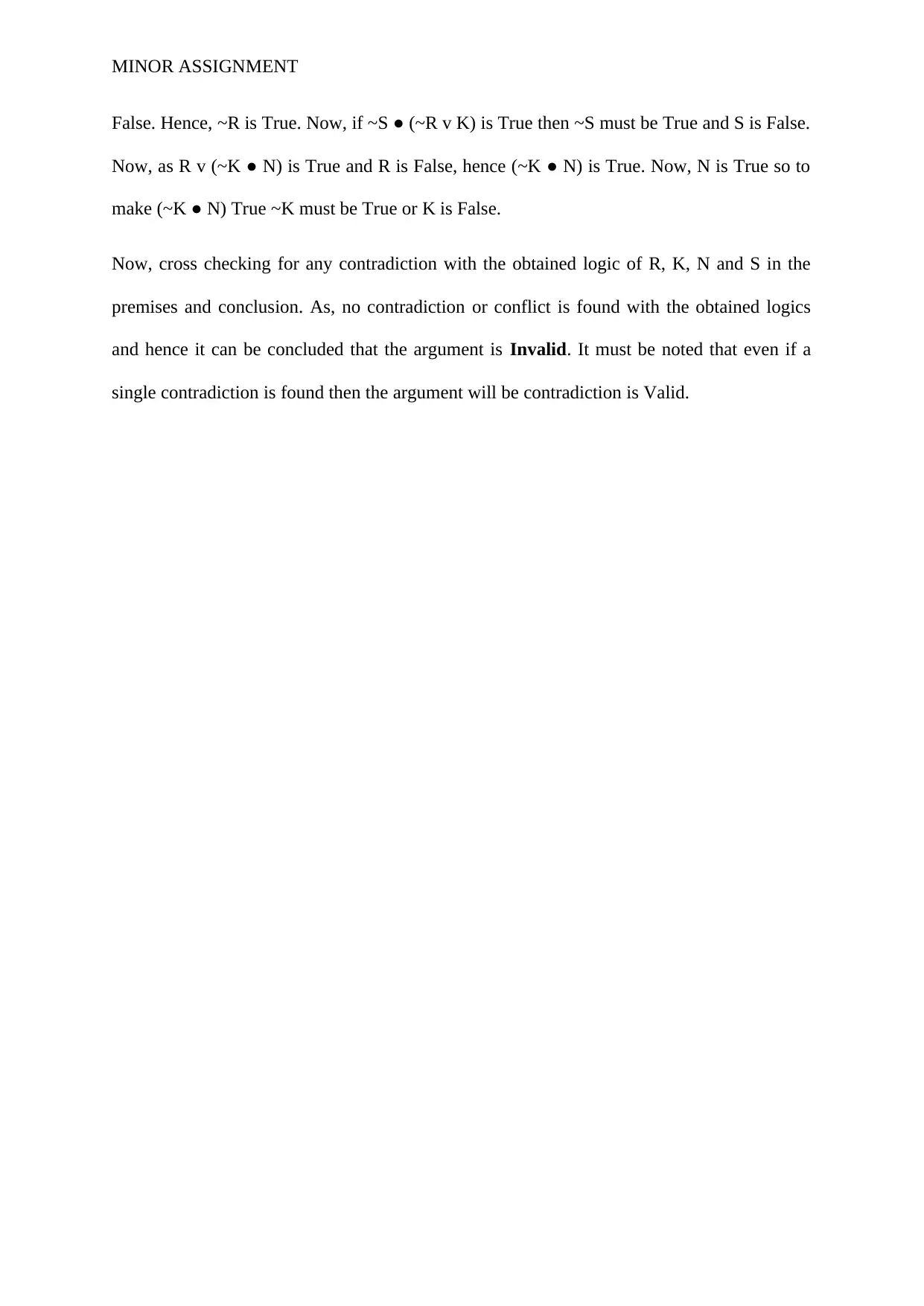
MINOR ASSIGNMENT
False. Hence, ~R is True. Now, if ~S ● (~R v K) is True then ~S must be True and S is False.
Now, as R v (~K ● N) is True and R is False, hence (~K ● N) is True. Now, N is True so to
make (~K ● N) True ~K must be True or K is False.
Now, cross checking for any contradiction with the obtained logic of R, K, N and S in the
premises and conclusion. As, no contradiction or conflict is found with the obtained logics
and hence it can be concluded that the argument is Invalid. It must be noted that even if a
single contradiction is found then the argument will be contradiction is Valid.
False. Hence, ~R is True. Now, if ~S ● (~R v K) is True then ~S must be True and S is False.
Now, as R v (~K ● N) is True and R is False, hence (~K ● N) is True. Now, N is True so to
make (~K ● N) True ~K must be True or K is False.
Now, cross checking for any contradiction with the obtained logic of R, K, N and S in the
premises and conclusion. As, no contradiction or conflict is found with the obtained logics
and hence it can be concluded that the argument is Invalid. It must be noted that even if a
single contradiction is found then the argument will be contradiction is Valid.
⊘ This is a preview!⊘
Do you want full access?
Subscribe today to unlock all pages.

Trusted by 1+ million students worldwide
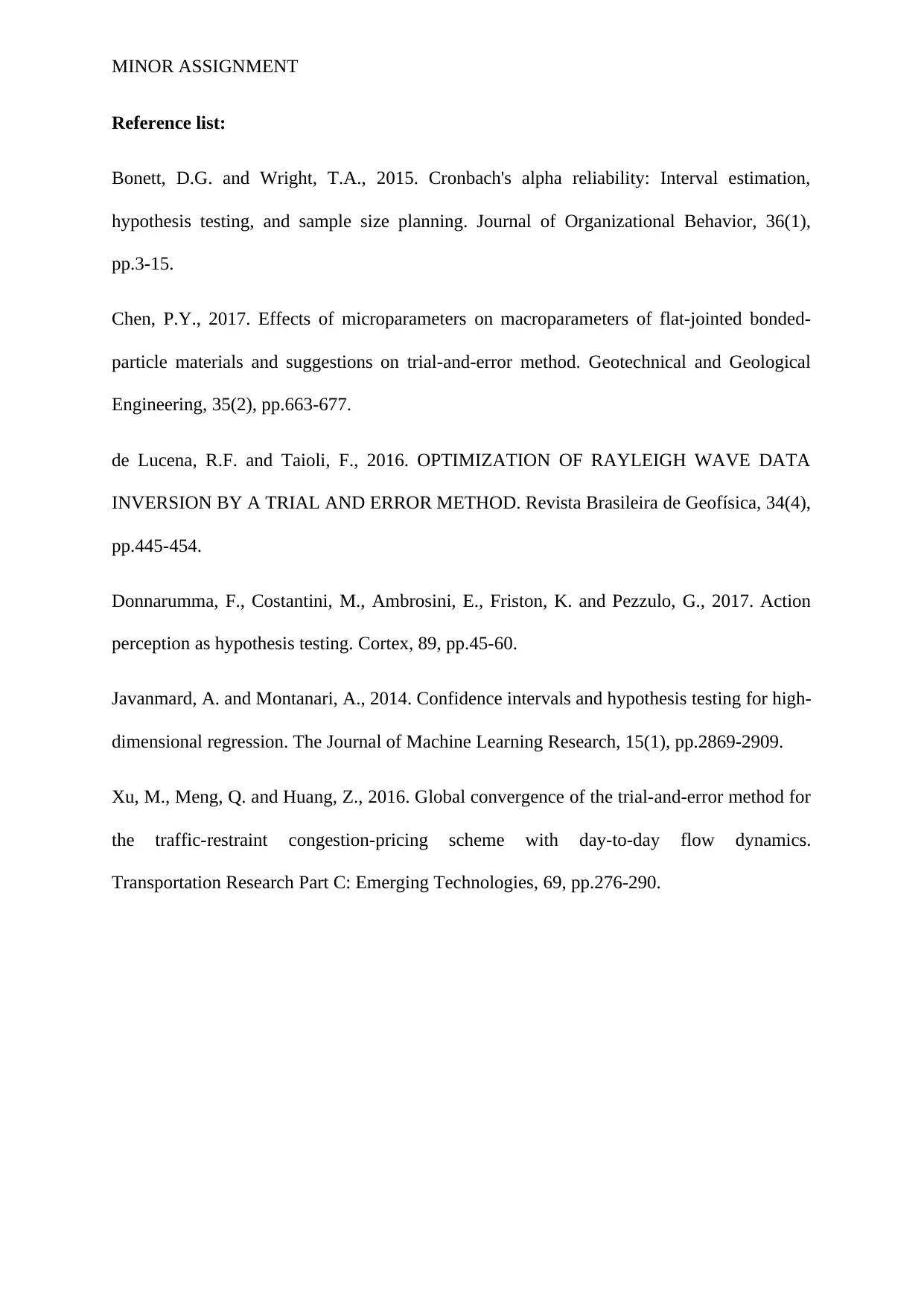
MINOR ASSIGNMENT
Reference list:
Bonett, D.G. and Wright, T.A., 2015. Cronbach's alpha reliability: Interval estimation,
hypothesis testing, and sample size planning. Journal of Organizational Behavior, 36(1),
pp.3-15.
Chen, P.Y., 2017. Effects of microparameters on macroparameters of flat-jointed bonded-
particle materials and suggestions on trial-and-error method. Geotechnical and Geological
Engineering, 35(2), pp.663-677.
de Lucena, R.F. and Taioli, F., 2016. OPTIMIZATION OF RAYLEIGH WAVE DATA
INVERSION BY A TRIAL AND ERROR METHOD. Revista Brasileira de Geofísica, 34(4),
pp.445-454.
Donnarumma, F., Costantini, M., Ambrosini, E., Friston, K. and Pezzulo, G., 2017. Action
perception as hypothesis testing. Cortex, 89, pp.45-60.
Javanmard, A. and Montanari, A., 2014. Confidence intervals and hypothesis testing for high-
dimensional regression. The Journal of Machine Learning Research, 15(1), pp.2869-2909.
Xu, M., Meng, Q. and Huang, Z., 2016. Global convergence of the trial-and-error method for
the traffic-restraint congestion-pricing scheme with day-to-day flow dynamics.
Transportation Research Part C: Emerging Technologies, 69, pp.276-290.
Reference list:
Bonett, D.G. and Wright, T.A., 2015. Cronbach's alpha reliability: Interval estimation,
hypothesis testing, and sample size planning. Journal of Organizational Behavior, 36(1),
pp.3-15.
Chen, P.Y., 2017. Effects of microparameters on macroparameters of flat-jointed bonded-
particle materials and suggestions on trial-and-error method. Geotechnical and Geological
Engineering, 35(2), pp.663-677.
de Lucena, R.F. and Taioli, F., 2016. OPTIMIZATION OF RAYLEIGH WAVE DATA
INVERSION BY A TRIAL AND ERROR METHOD. Revista Brasileira de Geofísica, 34(4),
pp.445-454.
Donnarumma, F., Costantini, M., Ambrosini, E., Friston, K. and Pezzulo, G., 2017. Action
perception as hypothesis testing. Cortex, 89, pp.45-60.
Javanmard, A. and Montanari, A., 2014. Confidence intervals and hypothesis testing for high-
dimensional regression. The Journal of Machine Learning Research, 15(1), pp.2869-2909.
Xu, M., Meng, Q. and Huang, Z., 2016. Global convergence of the trial-and-error method for
the traffic-restraint congestion-pricing scheme with day-to-day flow dynamics.
Transportation Research Part C: Emerging Technologies, 69, pp.276-290.
1 out of 7
Related Documents
Your All-in-One AI-Powered Toolkit for Academic Success.
+13062052269
info@desklib.com
Available 24*7 on WhatsApp / Email
![[object Object]](/_next/static/media/star-bottom.7253800d.svg)
Unlock your academic potential
Copyright © 2020–2025 A2Z Services. All Rights Reserved. Developed and managed by ZUCOL.





